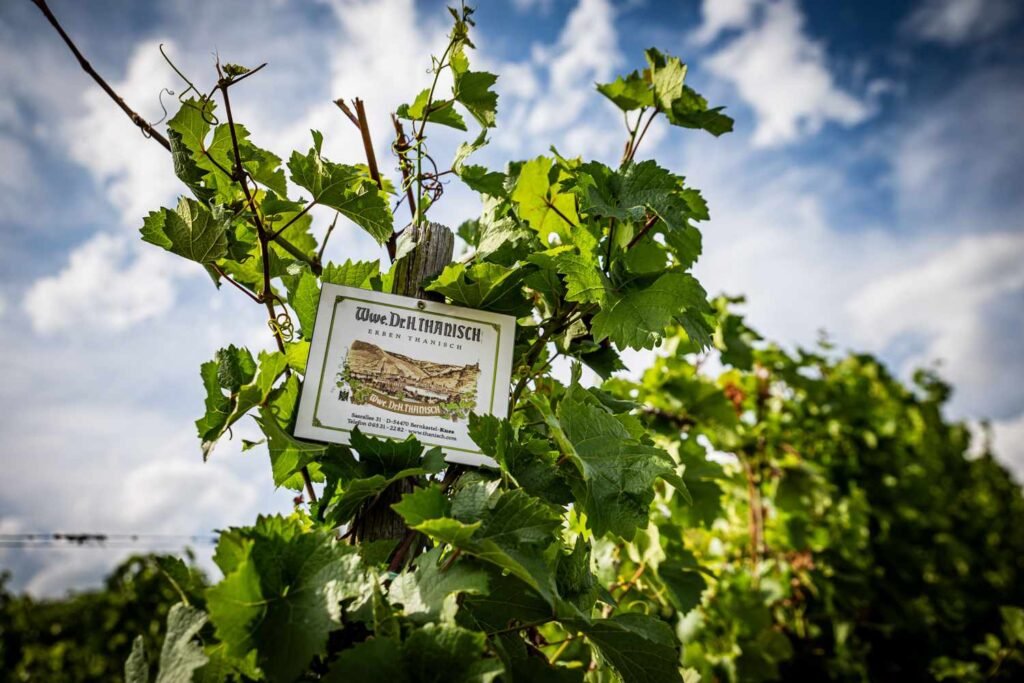Bernkasteler Doctor, one of Germany’s most renowned and expensive vineyards, grows Riesling and only Riesling on a steep, sun-soaked hill facing south-southwest on a sharp turn of the Mosel River. It overlooks the small, medieval town of Bernkastel in Germany’s most famous wine region.
According to legend, Bohemond II, Archbishop and Prince Elector of Trier from 1354 to 1362, “literally drank himself healthy on this wine,” says Christiane Heinen, press officer for Visit Mosel.
When doctors could not heal the feverish ruler during a visit to Landshut Castle, he turned to a barrel of local Riesling, and, after indulging, fully recovered. As the story goes, Bohemond exclaimed, “This is the true doctor!” and granted the vineyard the privilege of being called the Bernkasteler Doctor.
Courtesy of Weingut Wwe. Dr. H. Thanisch, Erben Müller-Burggraef
There is also evidence that English King Edward VII, the son of queen Victoria who ruled from 1901–1910, drank Berncasteler Doctor wine for its perceived healing properties as “medicine.” Such legends only further amplified the vineyard’s reputation and consumer interest.
Today, the prized vineyard — a mere 3.24 hectares, or roughly eight acres, in size — has a handful of owners and winemakers.
“When [Julius] Wegeler purchased 1.1 hectares in 1900, [Bernkasteler Doctor] became the world’s most expensive vineyard,” says Richard Grosche, estate director for Weingüter Wegeler, which owns the largest Doctor plot, including the site’s iconic winemaker’s hut that seats up to 12 guests.
Grosche says the church owns a Doctor plot of 0.25 hectares, or about 0.6 acres, which it leases it in two sections to vintners — currently Schloss Lieser and Weingut Markus Molitor — for eight-year periods at up to €19 (around $22) per square meter, or roughly the size of a single vine.
“This is a crazy price considering that you can buy grand cru vineyard sites starting at around €10 per square meter.”
Grosche estimates the entire vineyard’s output, at all distinction levels from all the wineries that work with grapes from the vineyard, would total no more than 12,000 to 15,000 bottles per year.
“The grapes from the Bernkasteler Doctor vineyard are highly prized because the steep slopes and the traditional single-pole training demand immense manual work and a lot of care,” says Christina Thanisch, who co-owns Weingut Wwe. Dr. H. Thanisch Erben Thanisch (Dr. Thanisch) with her mother, Sofia Thanisch.
Courtesy of Weingut Wwe. Dr. H. Thanisch, Erben Müller-Burggraef
Grosche agrees, noting that producers can expect to work up to 2,400 hours per hectare each year on a steep site like the Doctor, versus about 450 hours on a flat vineyard.
“Beyond this effort, the site itself is truly exceptional: It has a unique microclimate that gives the wines their remarkable character and has earned the vineyard an outstanding reputation worldwide,” says Thanisch. “Due to the south-southwest orientation to the sun, we have warm characters in the wines, paired with a lot of saltiness and minerality from the slate soil.”
In addition, Grosche points out a unique slate formation that may be key to the health of the site.
“If you stand in our Doctor cellar — carved into the mountain back in 1650 — you see that the slate isn’t layer on layer but has risen vertically,” he says.
He believes this composition allows the vines, some up to 120 years old, to root even more deeply than normal, keeping them nourished even in the hottest and driest years.
In turn, the Doctor wines themselves offer elegant intensity, ripe fruit complemented by herbaceous character, and lots of minerality on the palate. Thanisch recommends that first-time Doctor drinkers sample Riesling Kabinett, a dry to off-dry wine made from ripe grapes, and Spätlese, a more concentrated late-harvest wine, which she says are styles emblematic of the region. Grosche also notes that Doctor wines can age beautifully for decades.
Courtesy of Christopher Arnoldi / Christopher Arnoldi Weingut Wwe. Dr. H. Thanisch, Erben Müller-Burggraef
You can find Doctor wines at a variety of shops and tasting rooms in the Mosel region, including Dr. Thanisch’s beautiful vinotheque in Bernkastel-Kues, which faces Bernkastel’s old town, vineyards, and the imposing ruins of Landshut Castle from across the river.
To taste on-site with Wegeler, you’ll have to visit the company’s Rheingau vinothek in Oestrich-Winkel, just west of Mainz on the Rhine River, or make an appointment at the Mosel vinothek.
For anyone unable to sneak away to Germany, California-based importer The German Wine Collective includes Wegeler in their portfolio, and Total Wine & More carries a Kabinett, a Spätlese, and an Auslese from Dr. Thanisch, which range from $50–110.
Considering the history of the site and the cost and challenges of working it, the prices seem eminently reasonable. Wegeler has been crafting wine since 1882, while Dr. Thanisch was founded in 1636 and has been run by the women of the family since 1895; Christina is the fifth generation of Thanisch matriarchs to lead the operation.
“As a traditional company with 400 years of history, sustainability is part of our DNA,” she says. “Each generation has passed on the vineyards and their surroundings in good condition to the next. It is an honor, and at the same time a great responsibility.”


